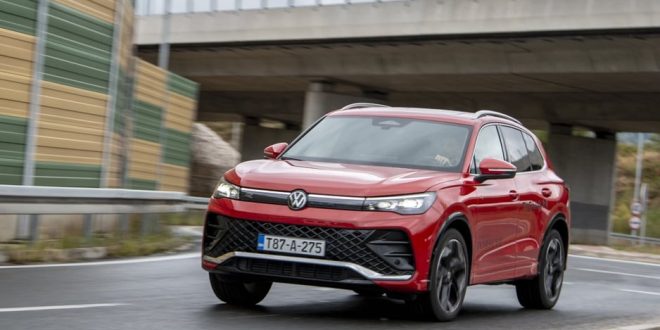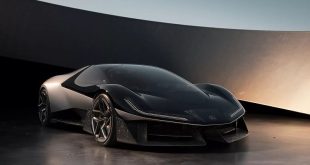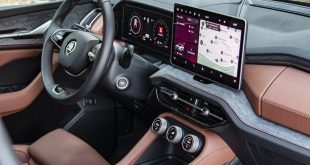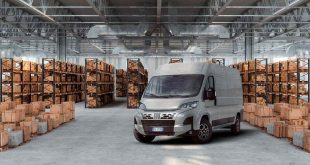At a time when the auto industry is in unknown territory and a turning point for which it is still not certain which way it will go, few expected that a classic but popular SUV would be so important. For Volkswagen, the new Tiguan has taken on a completely new role.The transition to full or partial electromobility is not going at the pace planned for now, and Volkswagen, as one of the largest and most popular car brands, in addition to being dedicated to this goal, must also be dedicated to the present and the clear wishes of customers. This is why this year will be marked by the 50th birthday of the Golf as their most popular and most important model, but also by the fact that the Tiguan suddenly became the second most important model. Not the Polo, not even the Passat, but the Tiguan. More than enough reason to check what the new generation SUV from Wolfsburg has to offer, in its current most luxurious version.
In this third generation, the Tiguan thus comes with the burden of success, but judging by the initial response of the market, this will not be a problem for it. The order lists are full, and Volkswagen is struggling to produce all the ordered copies. This phenomenon of early success is probably due to the fact that here Volkswagen stuck to their tried and true recipe that their customers love so much. Instead of major changes and radical innovations, the Tiguan is a detailed and precise evolution of its predecessor, both visually and technologically. The recipe that has brought great success and popularity to the Golf through eight generations obviously works here as well.
The evolution of a well-known and proven good platform, the modernization and electrification of proven engines, and a design that flirts with electrified models but is still recognizable, and a handful of technology and sparkling screens seem to be a winning recipe for this Tiguan, but probably also for other models from Wolfsburg.
Recognizable by connection with the ID family
Although it appears to be significantly larger and more luxurious, the new Tiguan has grown by only 3 cm in length compared to the third generation, where the wheelbase has become only 1 mm longer, and it is even 19 mm lower in height. Nevertheless, lavishly designed fenders that are extremely widened and thrown out, a large bumper whose air vent, at least visually, extends across the entire width of the car and a few other design details make the Tiguan look significantly larger than its predecessor.
What is more important than the appearance and design, which, as we are used to from Volkswagen, represents an evolution and not a revolution of what has already been seen, are the essential changes on the MQB Evo platform, which, in addition to saving weight, enabled raising the level of quality and strength, as well as the introduction of new technology and improving the suspension itself.
The concept itself has remained the same, proven and well-known four-cylinder engines in combination with front or all-wheel drive and an automatic transmission is a recipe that cannot be wrong in this SUV segment. Now with the option of hybrid electrification, the Tiguan has also received a new dose of economy and usability.
Volkswagen quality as we know it
What Volkswagen is known for is a sense of quality, both in the interior and when handling. With the new Tiguan, it seems that he has returned to that familiar path, so even when opening the doors, which are moderately heavy, and when closing, they leave the impression of massiveness. True, the luxurious R Line equipment package also brings with it the best materials from the range, so the pleasant and generously sized “ergo” seats are upholstered in high-quality and comfortable leather, while the dashboard and central console are also covered in pleasant and soft leather.

Photo: EZ/Klix.ba
Although the cockpit is now fully digitized, there are no major innovations in the design of the driver’s environment. The biggest and most important innovation is the shift lever, which, as with other models of the new generation, has been moved from the central tunnel to the steering column, and is almost identical to the one on the electric ID models. At first, it takes a little getting used to, but after a few uses, choosing between the gears becomes a fairly automatic movement.
In addition to the ergonomic advantage, this also made it possible to free up space on the central tunnel, so in addition to huge compartments and a very original and practical “drawer” for phones with wireless charging, there is now an attractively designed multifunctional controller with which you can control the volume or change the color of the ambient light. Obviously, Volkswagen realized that some physical controls are still a necessary and safer solution, if only to do the same with the air conditioning controls, as Škoda did for example.

Photo: EZ/Klix.ba
Of course, the main detail of the interior is the large infotainment screen, in our case the Discover Pro has a diagonal of 15 inches, so it’s no wonder that at first it seemed to us that someone opened a laptop in front of the driver. The screen itself, the interface and the software have been significantly refined and improved, and it seems that the new MIB4 platform has corrected the previous imperfections. Responsiveness of the screen and menu is excellent, and moving through the functions is quite simple and, thanks to the large screen, very clear. Essentially, the only drawback that we noticed is the quality of the “image” from the reversing camera, which is of rather poor resolution compared to the rest of the functions on the screen, and we noticed the same with other current models from the Volkswagen group.
What is more important than the screen itself is the space and comfort in the cabin, and the Tiguan is one of the best in the segment. With the optional seats, comfort and cornering are excellent, while there is more than enough space in all seats. With a large panoramic roof and a sense of airiness, it is enviable, and the trunk volume of 652 liters is up to the task. It’s no wonder that the Tiguan is a family favorite.
Powerful powertrain with a new dimension of comfort
Despite all the challenges, it must be admitted that Volkswagen managed to survive with one of the most complete engine offers for all its models. Thus, with an excellent range of proven four-cylinder engines, the Tiguan is one of the most serious SUVs in this class, and regardless of whether you choose the weakest or the most powerful version, you can be sure that there is an optimal engine under the hood.
Although hybrids and electrification are the biggest innovations in this generation, we chose the proven and powerful TDI for the first introduction. Whether you want to admit it or not, if you use your Tiguan for business and family needs, the fact is that a powerful and economical diesel still offers an unbeatable combination of practicality and economy. In the most powerful version available, which we tested, the 2.0 TDI thus produces 193 hp and, more importantly, a fine and round 400 Nm of torque available from 1,750 rpm. With the additional improved DSG gearbox with a double clutch, we were once again convinced why this is the ideal measure for an SUV of this format.

Photo: EZ/Klix.ba
Regardless of whether you want to travel at a leisurely pace or would still use almost all 200 hp, this powertrain is well balanced, and with the option of choosing well-programmed operating modes, it is easy to turn the Tiguan from a soft sedan into an almost real sports car. In addition to the powerful engine, great credit goes to the four-wheel drive, but even more to the new generation adjustable DCC Pro suspension, where the shock absorbers have received an additional compression chamber for even more adjustment options, but also for an extra dose of comfort. With excellent sound insulation, good materials and this suspension, the new Tiguan is definitely the most comfortable Volkswagen we’ve driven recently. Of course, even here we would still like to have a smaller number of rims and a slightly larger side profile of the tires, which would certainly add another dimension of comfort and quieter crossing over bumps, which is more befitting of this type of car.
- Roughly comparable competition – basic models :
- Hyundai Tucson 1.6 T-GDI Art – 54,900 KM
- Škoda Karoq 1.0 TSI Essence – 52,531 KM
- Toyota RAV-4 2.5 VVTi HSD Limited – 79,740 KM
- Mazda CX-5 Prime Line G165 – 61,780 KM
- Peugeot 3008 1.2 MHEV Allure – 63,116 KM
- Nissan Qashqai 1.3 DIG-T Visia – 58,900 KM
- Renault Austral MHEV 130 Evolution – 63,800 KM
- Volkswagen Tiguan 1.5 eTSI Life Plus – 69,999 KM
It breaks the records of orders and popularity
In the third generation, Volkswagen did not want to gamble with the Tiguan, which in the meantime has become the brand’s best-selling model globally. They admitted to themselves that they had to return the quality of workmanship and materials to the level that everyone expects from them, and instead of a revolution, they returned to the evolution of a well-received model.
In the end, the result is expected and excellent at the same time, and this is shown by the market that Wolfsburg flooded with orders. Of course, the reason for this is not the fact that the Tiguan is the most affordable model in its class. It never was, nor will it ever be, but in the general increase in prices it managed to stay in a very well measured range of offers in this segment.
Of course, models like the test one, which had almost all possible options, are far from the best-buy model rating, so with a price of almost 115,000 marks, they serve more as a demonstration of the range of offers and technology available in the Tiguan. For those more rational and practical who do not see the point of a sports package on a family SUV, it is possible to pack a very attractive model for some 30 thousand marks less, which with comparable equipment is the average of this class.

Photo: EZ/Klix.ba
In essence, it is clear that Volkswagen has done a complete job with the new generation Tiguan, so although we would like to see some details in an even more classic version, the fact is that they are now on the right track and have reminded themselves why the market loves their cars.
- Basic data about the test car: Volkswagen Tiguan R-Line 2.0 TDI 193 HP DSG7 4Motion
- Price of the basic model: 76,674 KM
- Price of the test model: 114,606 KM
- Engine: front transverse, four cylinders, 16 valves, diesel, turbocharger. Working volume 1,968 cc. Maximum power 193 hp at 3,500 to 4,200 rpm. Maximum torque 400 Nm from 1,750 to 3,500 rpm.
- Power transmission: Adaptive plug-in drive via both axles. 7-speed automatic transmission with two clutches (DSG). Rims with a diameter of 20 inches, tires 255/40 R20.
- Performance and fuel consumption: Acceleration from 0 to 100 km/h – 7.7 s. Maximum speed – 220 km/h. Average consumption during the test – 7.8 l/100 km. Factory declared fuel consumption WLTP in mixed conditions – 6.1 to 6.4 l/100 km. Fuel tank volume – 58 l. Average CO2 emission – WLTP – 141-154 g/km. Euro 6e.
- Dimensions: Length – 4,539 mm. Width – 1,842 mm. Height – 1,656 mm. Wheelbase – 2,680 mm. Trunk volume – 652 liters. Unladen weight – 1,675 kg.
- Standard equipment: Volkswagen Tiguan R-Line 2.0 TDI 193 HP DSG7 4Motion
- Additional equipment on the test car: Glass panorama sunroof, “Harman Kardon” sound system, 10+1 speakers, Comfort package: Alarm system – Easy Open & Close – el. sensor-controlled opening and closing of the trunk lid – Keyless Advanced vehicle locking and engine start system, IQ.DRIVE assistant package: – “Area View” camera system for monitoring the environment – Travel Assist – Electrically folding, heated, exterior mirrors, automatically dimming with memory function “York” 8.5J x 20, Black, diamond-turned, with tires 255/40 R20, IQ LIGHT – HD matrix front lights, 3D LED rear lights with dynamic direction indicator “Dynamic Light Assist”, possibility of autonomous light control high beam beam, Steel spare wheel, tool and jack, Infotainment package plus: Navigation system “Discover Pro Max” 15″ – IDA voice assistant” – 2 USB-C ports at the front, 2 USB-C charging sockets on the center console at the back – Bluetooth interface for mobile phone with inductive charging function, Head-up Display, Laminated safety side windows, rear side windows and rear window tinted, “Varenna” leather upholstery with ergoActive front seats, Sports front seats, electrically adjustable front seats with memory function, heated steering wheel, without folding passenger seat, Heated front seats, Ventilated front seats with massage programs, automatic heating of the windshield washer nozzles.
- Warranty: 5 years or 150,000 kilometers.
 Blicnet Informacije na klik od tebe.
Blicnet Informacije na klik od tebe.




